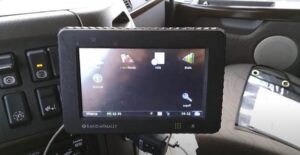
The realm of ELD lights is as fascinating as it is crucial in modern technology. These lights, more than mere indicators, serve as a language of communication for devices, conveying critical information about functionality and status. This article will explore the intricacies of ELD lights, shedding light on their varied meanings and the essential role they play in our daily interaction with technology.
What Are ELD Lights?
ELD lights, or Electronic Logging Device lights, are compact, typically LED-based indicators that can be found on a wide variety of electronic devices. These lights serve a crucial role beyond their aesthetic appeal; they are designed to convey essential information about the status of the device on which they are installed. Let’s delve into the significance and various applications of ELD lights.
The Significance of ELD Lights
ELD lights play a pivotal role in enhancing user experience and ensuring the efficient operation of electronic devices. Below, we will explore their significance in three primary aspects:
Status Indicators
One of the most fundamental functions of ELD lights is to serve as status indicators. These lights communicate critical information about the operational status of a device to the user. This information includes but is not limited to:
- Power On/Off: ELD lights often indicate whether a device is powered on or off. A glowing light might signify that the device is active and ready for use, while a lack of illumination could indicate a powered-off state;
- Charging Status: In the case of devices with rechargeable batteries, ELD lights can show the charging status. They may flash or change color to indicate various charging stages, such as charging in progress, fully charged, or low battery;
- Connectivity Status: For devices that rely on connections, such as Wi-Fi or Bluetooth, ELD lights can signal the status of these connections. A blinking light might imply that the device is searching for a connection, while a steady light can indicate a successful connection.
Alerts and Warnings
ELD lights are not limited to providing status information; they also serve as important tools for issuing alerts and warnings to users. These alerts can be triggered by various conditions, including:
- Overheating: ELD lights may flash or change color to indicate overheating, helping users identify and address potential safety concerns promptly;
- Malfunctions: When a device encounters a malfunction or error, ELD lights can flash in a specific pattern or color, providing a visual signal that something is amiss;
- Security Alerts: In security-sensitive applications, ELD lights can be programmed to indicate security breaches or unauthorized access attempts, enabling swift responses to potential threats.
User Interaction
Another critical role of ELD lights is to guide user interaction with the device. They serve as intuitive visual cues that inform users when their input or action is required. This aspect of ELD lights is particularly valuable in scenarios such as:
- Device Setup: During the initial setup of a device, ELD lights can provide step-by-step guidance. For example, a series of flashing lights may indicate that the user should perform specific actions to complete the setup process;
- Input Confirmation: After entering commands or settings, ELD lights can confirm successful input by changing color or displaying a steady light, assuring the user that their instructions have been received and implemented.
The Language of ELD Lights

Electronic Logging Device (ELD) lights are not just mere indicators; they communicate essential information about the status and operation of electronic devices. Let’s explore how deciphering their blinking patterns can provide valuable insights into the device’s condition.
Common Meanings of ELD Lights
ELD lights use a visual language to convey critical information to users. Here are some common meanings associated with different ELD light colors:
| Light Color | Meaning |
| Solid Green | Typically indicates a fully operational status or a successful completion of a process. |
| Blinking Red | Often signals an error or a critical warning. |
| Yellow/Orange | Usually denotes a standby mode or a need for user attention. |
Understanding these basic color associations is the first step in interpreting the status of your electronic device. Now, let’s take a closer look at how blinking patterns can further enhance your understanding.
Deciphering Blink Patterns
The blinking patterns of ELD lights can carry specific meanings and provide more nuanced information about the device’s condition. Here are some examples of how blink patterns can be deciphered:
- Rapid Blinking: A rapid and continuous blinking pattern often indicates an urgent issue that requires immediate attention. This could signify a critical error, overheating, or a severe malfunction. Users should take prompt action to address the problem;
- Slow Pulse: On the contrary, a slow and rhythmic pulse of the ELD light may indicate a background process or a low-priority alert. This is typically used when the device is performing routine maintenance tasks, updates, or minor system checks. While it doesn’t require immediate action, it’s still useful for users to be aware of such background activities;
- Alternating Colors: Some ELD lights may alternate between colors, such as red and green. This alternating pattern can indicate a transition or a change in the device’s state. For example, it might signal that the device is in the process of starting up or shutting down. Users should wait for the process to complete before taking further action;
- Pattern Sequences: In more advanced systems, ELD lights can use complex pattern sequences to convey specific information. For instance, a series of short, rapid blinks followed by a brief pause may represent a unique error code. Users can refer to the device’s user manual or documentation to interpret these codes accurately.
By paying attention to these blinking patterns and their associated meanings, users can quickly assess the condition of their electronic devices. This not only helps in identifying and addressing issues promptly but also enhances user experience by providing clear and actionable feedback.
ELD Lights in Action: Real-World Examples
Electronic Logging Device (ELD) lights find diverse applications across a wide range of devices and systems, providing users with valuable information and enhancing their overall experience. Let’s explore real-world examples of ELD lights in action and delve into the advanced technology and design considerations associated with them.
Computers and Laptops
In the realm of computing, ELD lights play a pivotal role in conveying crucial information to users. Here are some common uses in computers and laptops:
| Device Component | ELD Light Functionality |
| Power Indicator | ELD lights indicate whether the device is powered on or off, often with a solid green for on and no light for off. |
| Battery Status | They display the battery charging status, typically with different colors or blink patterns to indicate charging, fully charged, or low battery. |
| Hard Drive Activity | ELD lights can show hard drive activity, blinking when data is being read or written, providing a visual cue of system responsiveness. |
| Connectivity Status | For devices with Wi-Fi capabilities, ELD lights signal connectivity status, helping users troubleshoot connection issues. |
Smart Home Devices
Smart home devices rely on ELD lights to communicate various statuses and interactions:
| Device Functionality | ELD Light Functionality |
| Connectivity Status | ELD lights indicate connectivity to the home network, making it easy for users to determine if their device is online. |
| Voice Recognition | When voice commands are recognized, ELD lights can provide feedback, confirming that the device is listening and processing requests. |
| Error Messages | In case of errors or issues, ELD lights can display specific patterns or colors, guiding users to troubleshoot effectively. |
Vehicles
Modern vehicles utilize ELD lights on their dashboards to inform drivers about essential vehicle functions:
| Vehicle Information | ELD Light Functionality |
| Engine Status | ELD lights convey critical engine information, such as whether the engine is running smoothly or if there’s a malfunction. |
| Fuel Levels | They provide an indication of fuel levels, helping drivers plan refueling stops in advance. |
| Maintenance Needs | ELD lights can alert drivers to maintenance needs, such as oil changes, tire pressure, or other service requirements. |
Advanced ELD Lights Technology
In recent years, advancements in ELD light technology have expanded their capabilities:
- Color Variations: Modern ELD lights are no longer limited to traditional red, green, and yellow. A spectrum of colors is now employed to convey more nuanced information. For instance, blue might indicate a successful update, while purple could signify a system diagnostic check;
- Smart ELD Lights: With the integration of smart technology, ELD lights are becoming more intelligent. They can adapt their color or blinking patterns based on the device’s status or user preferences. This personalization enhances the user experience and allows users to customize the device feedback to their liking.
ELD Lights and User Experience

ELD lights serve not only as information indicators but also as tools to enhance user experience:
- Enhancing Accessibility: ELD lights are particularly beneficial for enhancing accessibility. They provide clear visual cues that are invaluable for users with hearing impairments or for situations where auditory feedback may not be suitable, such as noisy environments;
- Design Considerations: The design of ELD lights is a crucial aspect that requires careful consideration. They must be noticeable but not distracting. Furthermore, their meanings should be intuitive and consistent across different devices to ensure users can quickly understand their significance.
Conclusion
ELD lights are more than just indicators on a device; they are a silent yet eloquent language that communicates vital information. Understanding their meanings enhances our interaction with technology, making our experiences more intuitive and efficient. As technology evolves, so will the capabilities and sophistication of ELD lights, continuing to light our way in the digital world.
FAQ
Can the color of ELD lights be customized?
In some devices, yes. This depends on the device’s capabilities and user settings.
Do all devices use the same ELD light meanings?
While there is some standardization, meanings can vary between manufacturers. Always refer to the device manual for specific interpretations.
Are ELD lights only found in electronic devices?
Primarily, yes. However, the concept of using lights for status indication is applied in various fields, like aviation and maritime signaling.
Can ELD lights fail?
Like any component, they can malfunction. Regular device maintenance is recommended to ensure their proper functioning.





